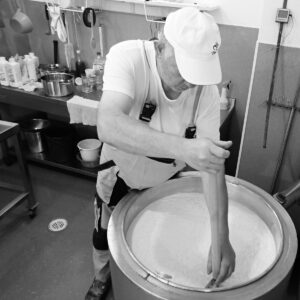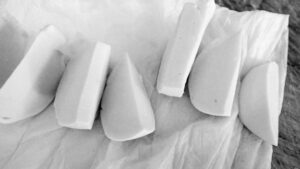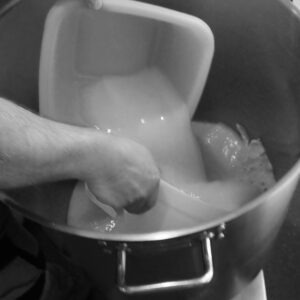Owner: Putnoky-Csicsó Barna
Place: Nyújtód/Lunga
We went to a farmhouse dairy in the village of Nyújtód/Lunga. From the outside, it looked like we had come to a bungalow with a second house, but once we entered the second one, we could see that we had entered a small dairy. It had a rather large stainless-steel tank and another one in copper where Mr. Putnoky-Csicsó Barna was stirring freshly milked cow’s milk.
They have 15 Tyrolean grey cows next to their house.
They make dairy products like
cheese with cumin
cheese with mushrooms
mozzarella with cow’s milk
ricotta cheese
smoked cheese
yogurt
cheese rolls called sajttekercs. A recipe in Hungarian can be found here.
cheese with blackcurrant homemade wine
The last one was not made this year because the summer was too dry.
To make mozzarella cheese, they lay cheese in lukewarm water, knead it, take out pieces and roll them into spheres. Next, they must stay in salt water for 2 weeks.
He let us taste the mozzarella cheese, which was very good. An article about how mozzarella is made at an Italian farm is described here.
During our visit, he was working hard to make cheese because he would sell it at a market on Saturday.
He told my guide that cheese should be served at room temperature and not like I think many people do: eat it straight from the fridge.
There was a storeroom in the basement and an adjacent room.
The cheeses are stored in containers filled with brine, staying there for 3-4 hours per kg. Thus, a heavy cheese must stay longer in brine than a light one.
Next, the cheeses are stored in a cool room on wooden shelves, while turning them upside down daily to expel whey and brushing them with salt water to prevent mould for 2 weeks. Thereafter, the same procedure is repeated every second day for 3 months.
Barna had a tool which he can use to extract a sample of a maturing cheese, smell and taste the sample and then reseal the cheese. He’s also knocking on the cheese, listening to the resulting sound. Interestingly, bakers at a bakery in Sardinia are knocking on their sourdough breads to listen if they have the right consistency.
Occasionally, Barna put a perforated bowl into the milk in the copper container, next he used another bowl to scoop up whey, which had been filtered by the sieve. Finally, he emptied the bowl in a stainless-steel container. Later, he would reheat the whey to make ricotta cheese. That is, the whey is heated twice, and the remaining curd is extracted and used to make the ricotta.
He also filled a glass with whey, and he gave each of us a small cup of it. He emptied the glass, and he told my guide that it was very healthy, and it contains lots of proteins.
He occasionally stirred the milk in the copper container with a harp and gradually small aggregates, called curd, started appearing on the surface. To separate curd and whey, he transferred the whey to another tank.
He holds free courses for those who want to learn about cheesemaking.
He showed us a round shape on which he put a porous cloth. When the curd was ready, he would put it on the cloth which would filter out the whey. In addition, it would give the surface of the cheese an uneven surface.
In 2012, he went to a 6-month course with Hungarian cheesemakers. After 5-6 years of making cheese, he went to Switzerland where he met a group of Swiss cheesemakers, one of whom had been doing it for 40 years. They taught him lots of details he didn’t know about.
He holds events about cheese for kindergartens and schools and he lets kids come to the dairy where they can make strange shapes of the cheese.
He said you can leave whey for 2-3 months; it will turn sour and it’s good for the veins.



